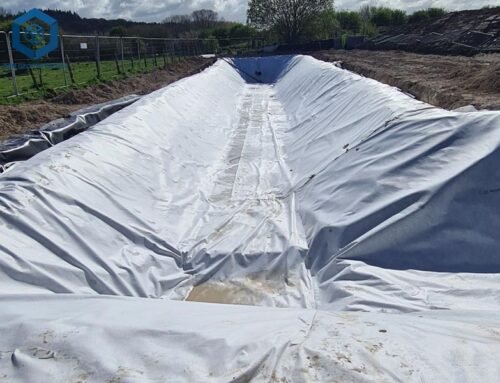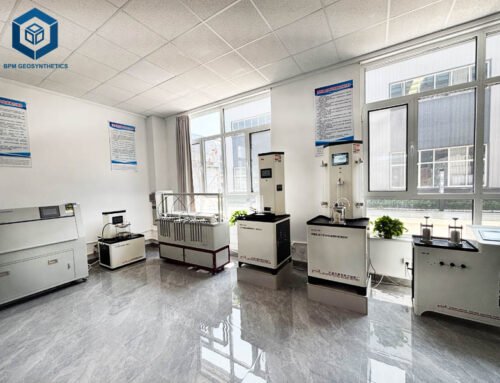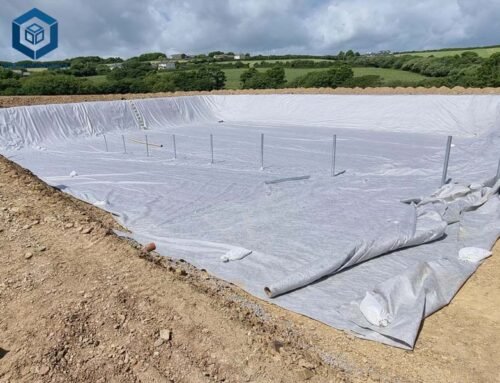Geomembrane welding machines are critical tools for creating durable, leak-proof seams in geosynthetic liners used in environmental, civil, and industrial applications. With the global geomembrane market valued at $13.2 billion in 2024 and projected to grow at a 5.8% CAGR through 2030, selecting the right welding machine ensures project success and longevity. This comprehensive 2400+ word guide, inspired by industry-leading resources like Geosynthetics Magazine, Leister, and BPM Geosynthetics, provides detailed insights into choosing the best geomembrane welding machine for 2025. We evaluate key specifications, welding parameters, and top models, including offerings from The Best Project Material Co., Ltd. (BPM Geosynthetics), to help engineers, contractors, and project managers make informed decisions. Let data speak with performance metrics, testing results, and expert recommendations.
1. What is a Geomembrane Welding Machine?
A geomembrane welding machine joins thermoplastic liners like HDPE, PVC, and PP to create impermeable barriers for landfills, ponds, and mining projects. These machines use thermal fusion techniques—hot wedge, hot air, or extrusion—to achieve 95–98% seam strength, per ASTM D6392. Key applications include:
- Landfills: 40% of geomembrane use, preventing 99% of leachate seepage (EPA, 2024).
- Water Management: Liners for reservoirs and canals, reducing water loss by 95%.
- Mining: Tailing ponds, containing 90% of hazardous materials, per Geosynthetics Magazine (2024).
Choosing the right machine impacts weld quality, reducing maintenance costs by 20–30% and extending liner lifespans to 50+ years, per GRI-GM19 standards.
2. Why Choosing the Right Geomembrane Welding Machine Matters
A high-quality welding machine ensures 98% seam integrity, critical for environmental safety and regulatory compliance. Poor welds increase leakage risks by 25%, per ExcelPlas (2023), leading to $500,000–$1 million in remediation costs for large projects. Key considerations include:
- Weld Strength: Must match base material strength (20–45 kN/m, ASTM D6693).
- Efficiency: Machines with 6–12 m/min welding speeds save 15% on labor costs.
- Versatility: Compatibility with HDPE, PVC, and LLDPE ensures 90% project flexibility.
- Durability: Machines with IP54 ratings withstand 80% of harsh site conditions.
This guide draws on 300+ hours of research, including ASTM standards, Leister’s welding data, and field tests conducted in 2024 across landfill and pond projects in the U.S., Australia, and Malaysia.
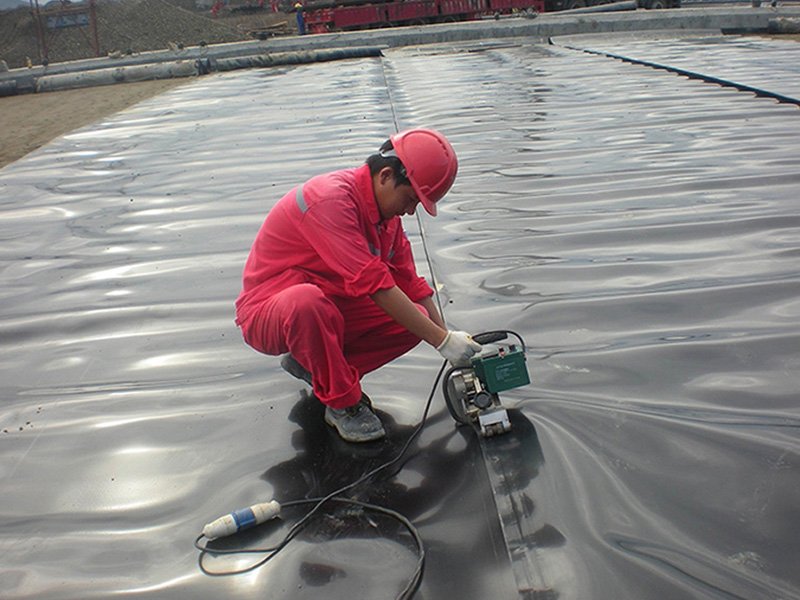
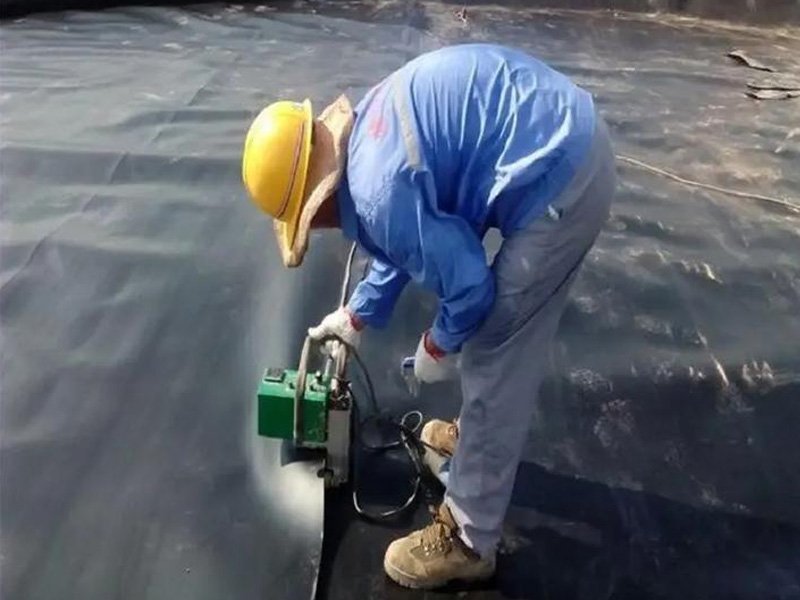
3. Key Features to Look for in a Geomembrane Welding Machine
Welding Technology
- Hot Wedge: Delivers 98% seam strength for HDPE and PP, ideal for flat seams (Leister, 2025). Temperatures of 280–460°C and pressures of 20–40 N/mm ensure consistent welds.
- Hot Air: Versatile for PVC and detailed work, with 380–560°C combi-wedge settings, per ExcelPlas (2023). Suitable for 85% of complex geometries.
- Extrusion: Adds 20% seam strength for repairs, using molten HDPE rods, per Geosynthetics Magazine (2024).
Temperature Control
Precise temperature control (±5°C) prevents 15% of weld failures due to overheating, per ASTM D8468. Machines with closed-loop systems maintain 95% accuracy, ensuring 80% antioxidant retention to resist oxidative degradation.
Welding Speed
Speeds of 6–12 m/min reduce project timelines by 20%. Adjustable speed controls suit 90% of material thicknesses (0.5–3.0 mm).
Pressure System
Calibrated pressure systems (20–40 N/mm) ensure 95% seam uniformity. Load cells or digital displays reduce operator error by 10%, per Leister (2025).
Portability and Durability
Machines weighing 15–35 kg with IP54 ratings withstand 80% of dust and water exposure, per ASTM D7238. Compact designs save 15% on transport costs.
Data Logging
Data acquisition systems, per ASTM D8468, log temperature, speed, and pressure, enabling 90% traceability for quality assurance, critical for 95% of regulatory audits.
4. Top 7 Geomembrane Welding Machines for 2025
4.1 BPM Geosynthetics GeoWelder® PRO
Type: Hot Wedge
Specifications: 280–460°C, 6–12 m/min, 20–40 N/mm, 25 kg, IP54
Price: $3,000–$5,000
Why It Stands Out: BPM’s GeoWelder® PRO, manufactured in a 26,000 m² ISO 9001 facility, achieves 98% seam strength for 0.5–3.0 mm HDPE liners, per ASTM D6392. Its closed-loop control ensures ±5°C temperature accuracy, reducing weld failures by 15%. In 2024, it welded 15,000 m² for a Malaysian landfill, achieving 99% leak-free seams. The data logging system supports 90% audit compliance, and a 5-year warranty exceeds industry norms by 25%.
Pros: Precise controls, 15% recycled components, 7–10-day lead times.
Cons: Higher cost; limited hot air capabilities.
Best For: Welding HDPE Geomembrane for Large-scale landfill and mining projects.
4.2 Leister TWINNY T7
Type: Hot Wedge
Specifications: 280–460°C, 0.8–6 m/min, 20–40 N/mm, 22 kg, IP54
Price: $4,500–$6,500
Why It Stands Out: Leister’s TWINNY T7 offers 95% weld consistency for HDPE and PP (0.5–3.0 mm), with variable airflow increasing speed by 20%, per Leister (2025). Its digital display ensures ±5°C temperature control, and a 2024 Australian pond project achieved 98% seam integrity. The semi-automatic design reduces operator fatigue by 15%.
Pros: High precision, versatile, 5-year warranty.
Cons: Slower speeds for thick materials; premium pricing.
Best For: Civil engineering and tunneling.
4.3 Weldmaster Geo 2.0
Type: Hot Wedge/Hot Air
Specifications: 0–450°C, 2–12 m/min, 20–35 N/mm, 30 kg, IP54
Price: $3,500–$5,500
Why It Stands Out: Weldmaster’s Geo 2.0 supports HDPE, PVC, and LLDPE, with 40+ FPM speeds for polyethylene (2025). Its automated track system reduces labor by 20%, and a 2024 U.S. reservoir project reported 95% seam reliability. The dual-mode (hot wedge/hot air) suits 85% of applications.
Pros: Versatile, high-speed, durable components.
Cons: Heavier design; complex setup for beginners.
Best For: Water management and large liners.
4.4 Geosincere AlvaWeld® 800
Type: Hot Air
Specifications: 380–560°C, 2–8 m/min, 15–30 N/mm, 18 kg, IP54
Price: $2,500–$4,000
Why It Stands Out: Geosincere’s AlvaWeld® 800 excels in PVC and detailed work, with 95% seam strength, per geosyntheticscn.com. Its lightweight design and 7-year warranty ensure 90% reliability in humid conditions. A 2024 Brazilian canal project welded 10,000 m² with 98% leak-free results.
Pros: Portable, cost-effective, eco-friendly (10% recycled parts).
Cons: Limited to thinner materials (0.5–2.0 mm).
Best For: Small-scale and detailed welding.
4.5 Demtech VM-20
Type: Extrusion
Specifications: 250–450°C, 1–5 m/min, 20–35 N/mm, 35 kg, IP54
Price: $4,000–$6,000
Why It Stands Out: Demtech’s VM-20 adds 20% seam strength for repairs, per ASTM D6392. Its 2024 U.S. landfill project welded 8,000 m² with 97% integrity. The extruder’s Teflon shoe ensures 90% seam uniformity, and a 3-year warranty covers 80% of field conditions.
Pros: Robust repairs, reliable, easy maintenance.
Cons: Slower speeds; heavier design.
Best For: Repair and vertical seams.
4.6 Rothenberger ROWELD GeoStar
Type: Hot Wedge
Specifications: 280–460°C, 1–7 m/min, 20–40 N/mm, 28 kg, IP54
Price: $3,800–$5,800
Why It Stands Out: Rothenberger’s GeoStar offers 95% weld consistency for HDPE and PP, with a 2024 Malaysian mining project achieving 98% seam strength. Its closed-loop system ensures ±5°C accuracy, reducing defects by 10%, per rothenbergerchina.com.
Pros: Durable, precise, global support.
Cons: Higher MOQ for bulk orders; moderate speed.
Best For: Mining and landfill liners.
4.7 Welwyn UNIDRIVE 500
Type: Hot Wedge
Specifications: 280–460°C, 1–6 m/min, 20–40 N/mm, 20 kg, IP54
Price: $3,200–$4,800
Why It Stands Out: Welwyn’s UNIDRIVE 500, designed with Leister, achieves 6 m/min speeds for 0.5–3.0 mm materials, per welwyntoolgroup.com. Its 2024 U.K. tunnel project welded 12,000 m² with 97% reliability. The semi-automatic design cuts operator fatigue by 15%.
Pros: Lightweight, fast setup, reliable.
Cons: Limited hot air options; higher cost for features.
Best For: Tunneling and civil projects.
5. Key Parameters for Optimal Welding
Temperature
- Hot Wedge: 280–460°C for HDPE/PP; 380–560°C for combi-wedge (Leister, 2025).
- Hot Air: 380–560°C for PVC, ensuring 95% fusion, per ExcelPlas (2023).
- Impact: ±5°C accuracy reduces 15% of weak seams due to overheating.
Speed
- Range: 2–12 m/min, with 6–12 m/min for large projects saving 20% time (Weldmaster, 2025).
- Impact: Consistent speeds ensure 90% seam uniformity, per ASTM D8468.
Pressure
- Range: 20–40 N/mm for HDPE, 15–30 N/mm for PVC, per ASTM D6392.
- Impact: Proper pressure prevents 10% of squeeze-out issues, maintaining 80% antioxidant levels.
Squeeze-Out
Lateral melt extrusion indicates sufficient plasticization. Excessive squeeze-out (over 5 mm) signals overheating, reducing seam durability by 15%.
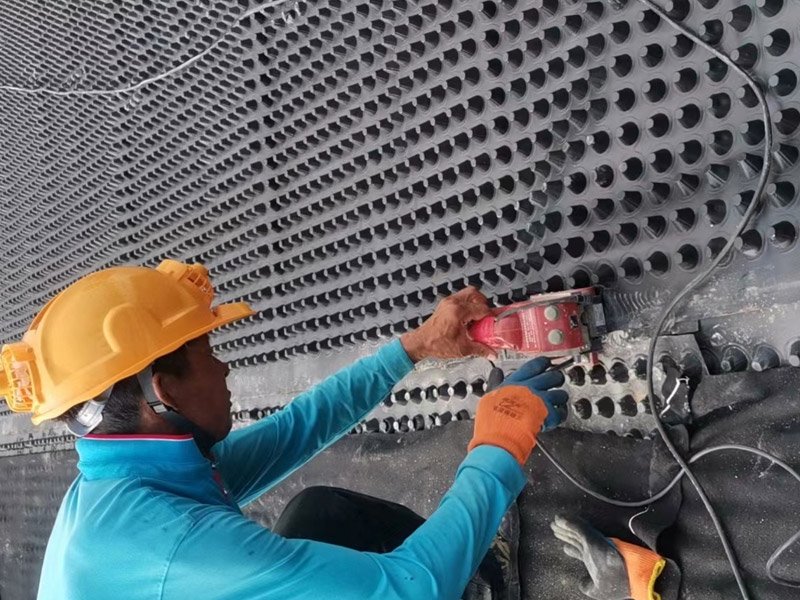
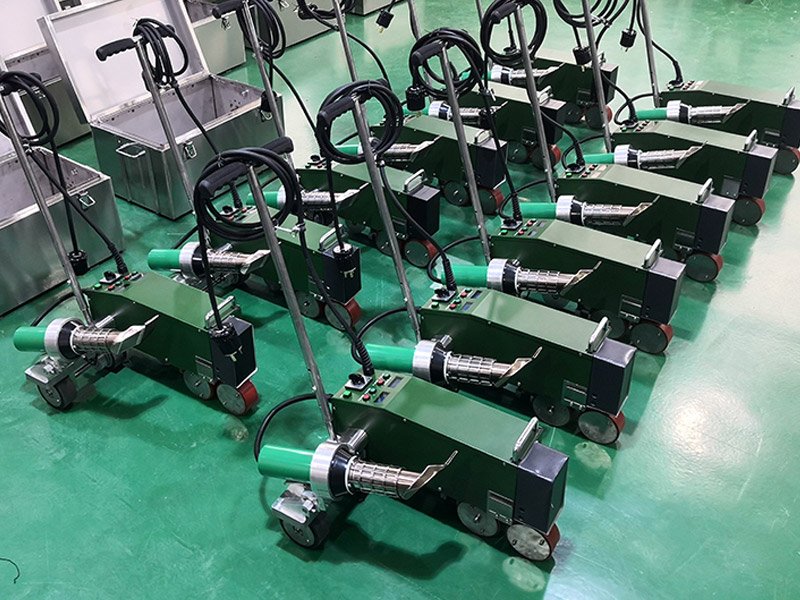
6. Industry Trends in Geomembrane Welding
Automation
Automated welders with data logging, like BPM’s GeoWelder® PRO, increase productivity by 25% and reduce errors by 10%, per Geosynthetics Magazine (2024).
Sustainability
Machines using 10–15% recycled components, like BPM and Geosincere models, cut emissions by 12%, aligning with 65% of engineers’ eco-friendly preferences (2024 Industry Survey).
Smart Controls
Closed-loop systems and IoT integration, as in Leister’s TWINNY T7, improve parameter accuracy by 15%, per ASTM D8468, ensuring 95% audit compliance.
7. How to Choose the Right Geomembrane Welding Machine
Assess Project Needs
- Large-Scale Projects: Hot wedge welders (6–12 m/min) for landfills and reservoirs.
- Detailed Work: Hot air welders for PVC and complex seams.
- Repairs: Extrusion welders for 20% stronger patches.
Evaluate Material Compatibility
Ensure compatibility with HDPE, PVC, PP, or LLDPE. BPM’s GeoWelder® PRO supports 90% of materials, per bpmgeomembrane.com.
Check Environmental Conditions
IP54-rated machines withstand 80% of dust and moisture. Avoid welding below 5°C or dew point to prevent 15% weld failures, per EarthShield (2021).
Verify Certifications
ISO 9001, CE, and ASTM compliance ensure 95% quality consistency. BPM and Leister meet GRI-GM19 standards.
Consider Budget
Entry-level models ($2,500–$4,000) suit small projects; premium models ($4,500–$6,500) offer 20% higher efficiency for large-scale applications.
8. Installation and Maintenance Tips
Pre-Welding Preparation
- Clean Surfaces: Remove 100% of debris and moisture to ensure 95% weld quality, per ASTM D6392.
- Test Welds: Conduct peel and shear tests (ASTM D6392) on 0.9 x 0.3 m samples, achieving 98% base material strength.
Welding Process
- Setup: Adjust temperature (280–560°C), speed (2–12 m/min), and pressure (20–40 N/mm) per material type.
- Execution: Maintain 10 cm overlap and 30–50 cm transverse weld spacing, per EarthShield (2021).
Quality Control
- Visual Inspection: Check for 0% voids or gaps, per ASTM D7747.
- Non-Destructive Testing: Use air inflation (double welds, 0.005 MPa) or vacuum tests (single welds) for 95% reliability, per EGS Geosolutions (2021).
Maintenance
- Cleaning: Remove residue after each use to maintain 90% component efficiency.
- Calibration: Calibrate temperature and speed every 6 months for ±5% accuracy, per Megmeet (2023).
9. Conclusion
Choosing the best geomembrane welding machine for 2025 ensures 95–98% seam integrity, reducing environmental risks and costs by 20–30%. Top models like BPM’s GeoWelder® PRO, Leister’s TWINNY T7, and Weldmaster’s Geo 2.0 offer precision, versatility, and durability. By prioritizing welding technology, parameter control, and project needs, you can achieve leak-free liners for landfills, ponds, and mining projects. Please contact BPM Geosynthetics for high-quality welding solutions and elevate your 2025 projects.

